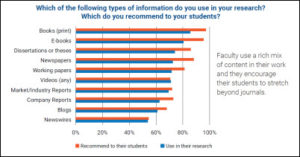Researchers Demand More Diversity in Content Sources
This post was originally published on the ProQuest Blog.
Research and teaching increasingly depend on a mix of content types beyond traditional scholarly journals, survey finds
While traditional peer-reviewed journal content remains a staple resource for researchers, a recent ProQuest survey indicates that research and teaching is informed by an increasingly diverse mix of content types. The survey demonstrates that library collections with a variety of content sources align more closely to changes in user needs and expectations – with the most dramatic shift in the demand for multimedia content.
The evolution in demand for video resources
The 2017 ProQuest survey is a follow-up to a similar one conducted in 2014 that asked a global population of graduate level through faculty researchers what types of content they used in their research and what types of content they recommended to their students. In the two years between surveys, video content showed the biggest spike in popularity among researchers.
In 2014, only 39% of respondents were incorporating video as part of their information gather. In 2017, use has rocketed up to 71%.
Requests for other resources on the rise
Additionally, Open Access journals are rising in credibility, with 72% of respondents tapping them and a whopping 89% of faculty recommending these journals to their students.
Additionally, as the research community crosses ever more geographic boundaries, non-English language scholarly journals are valued by more researchers – about 60% of survey respondents use them.
Other major changes were also related to the impact of relatively new technology: ebooks climbed from 69% to 80% of respondents using them. Usage of blog content also increased from 37% to 61% of respondents citing them. While still the most popular source for research, there was a significant decline in the use of print books, which has dropped from 95% to 83% of researchers citing their use.
Solutions
Libraries can match research and teaching trends by:
- Incorporating both print and ebooks as an important backbone of non-journal content
- Adding video collections to meet researcher needs for vetted, authoritative multimedia content
- Providing access to emerging research and voices with collections that include dissertations and working papers
- Ensuring access to company, industry and market reports for collections that support business researchers
- Staying ahead of journal trends by organizing and including OA and non-English materials in their collections or in their acquisition of aggregated materials
To balance budget requirements with researcher demands, libraries can consider building their foundational collections through acquisition of aggregated resources that embrace content diversity.
To find out more, download the ProQuest white paper.
The post Researchers Demand More Diversity in Content Sources appeared first on Ex Libris Initiatives.
Source: buki rss
Prijašnje verzije članka:
There are no revisions for this post.

